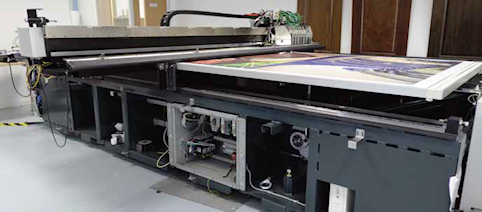Nessan Cleary takes a look at this heavy duty UV flatbed, designed mainly to churn out pop materials day after day.
INCA DIGITAL, based in Cambridge, was one of the early pioneers of flatbed UV printers. Its entry-level model is the Spyder, currently available in two versions, the Spyder V, featured here, and the Spyder 320.
 According to marketing director Heather Kendle, the Spyder V is slightly more popular in the UK and Europe because of its higher speed, achieved by having double the number of printheads with eight per colour. It uses the Spectra SE heads from Fujifilm Dimatix. The UV inks come from Fujifilm Sericol, which also handles all the sales and marketing for these printers. There's a choice of four or six colours, including CMYK plus either light cyan and light magenta, or orange and violet, or two white channels. However, it's not easy to change colours and can take two days to flush all the ink channels and change the filters. (For the record, the Spyder 320 offers a choice of four, six or eight printheads, which allows for more flexibility between inksets.)
According to marketing director Heather Kendle, the Spyder V is slightly more popular in the UK and Europe because of its higher speed, achieved by having double the number of printheads with eight per colour. It uses the Spectra SE heads from Fujifilm Dimatix. The UV inks come from Fujifilm Sericol, which also handles all the sales and marketing for these printers. There's a choice of four or six colours, including CMYK plus either light cyan and light magenta, or orange and violet, or two white channels. However, it's not easy to change colours and can take two days to flush all the ink channels and change the filters. (For the record, the Spyder 320 offers a choice of four, six or eight printheads, which allows for more flexibility between inksets.)
Maximum speed in four-pass mode is a very fast 120m2/hr, which produces print quality that’s more than adequate for most display applications. There's also a six-pass mode, and operators can choose between bi-directional at 83m2/hr, or a slightly better quality uni-directional mode, which runs at 49m2/hr.
Curing is via twin mercury arc UV lamps. Kendle says that Inca has looked at LED curing but says that it’s not fast enough, adding: “You have to tailor the ink differently because it works on a different wave length and it can give a different surface finish which can cause problems with post processing.”
The print carriage runs on air bearings with linear motors for precise control. At the heart of the printer is a solid fabricated steel framework. It will take substrates up to 3.2m x 1.6m, and up to 40mm thick. The bed will take 80kg in weight, with the entire bed dropping down to take the thicker materials.
The printer comes with a control station from which the operator runs all the maintenance and diagnostic functions. It's also possible from here to map between printheads nozzles in the event of a failure so that the machines can keep working until an engineer arrives to fit a replacement head.
Nozzle failure is a fact of life in the inkjet world but Kendle points out that although the machines have automatic cleaning for a basic level of maintenance, those customers who have a good maintenance regime can significantly reduce any nozzle failures.
The operator can also set the amount of vacuum on the bed, and choose the print speed and whether or not it's uni or bi-directional, as well as storing the jobs for reprints, but everything else to do with the job itself is done from the Rip. There's a choice of Rips from Wasatch, Colorgate and Caldera but, ultimately, all jobs are sent as PDFs to the print station. It’s possible to print multiple jobs across the bed, but the Rip has to first combine those jobs into a single PDF. There’s a lot of information available about each job such as the amount of ink used and the time taken to print it. Inca is developing the ability for customers to export that data as an excel file, an option that should be available in the next few months. All in all, this is a machine perfectly suited for high production environments.

